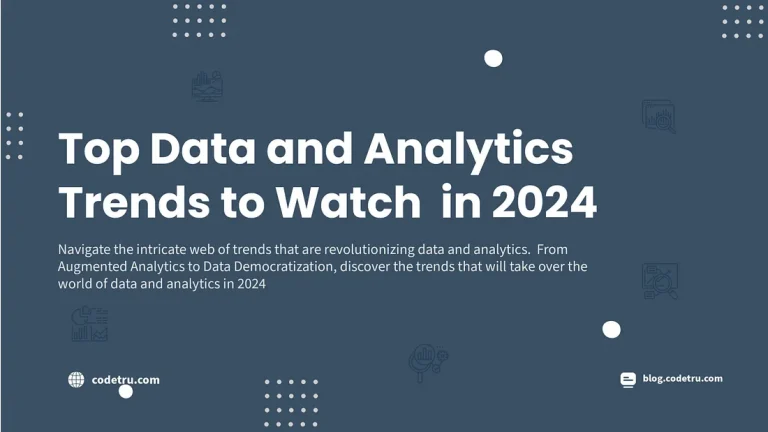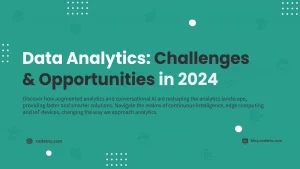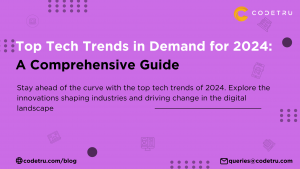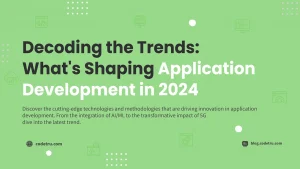In today’s data-driven world, businesses are swimming in an ocean of information. But simply collecting data isn’t enough — transforming it into actionable insights is the true currency of success
Data and analytics are transforming the way we live and work, enabling us to gain insights from massive amounts of data and make better decisions. As the world becomes more digital and connected, data and analytics are evolving to meet new challenges and opportunities. In this blog post, we will explore some of the key data and analytics trends that will shape the future of the field in 2024 and beyond.
Augmented Analytics
Gone are the days of data analysis being locked away in the ivory towers of data scientists. Augmented analytics leverages AI and machine learning to empower business users with intuitive tools for self-service analysis. Gartner predicts that by 2025, 70% of all analytics tasks will be automated, freeing up human analysts for more strategic tasks.
Augmented analytics is a term coined by Gartner to describe the use of artificial intelligence (AI) and machine learning (ML) to automate the data analysis processes. It reduces the complexity and manual effort involved in data preparation, exploration, and visualization, and to provide actionable insights to users in natural language.
It brings analytical capabilities easier for everyone, without the need for technical knowledge. It also helps analysts to perform deep and thorough analysis at a much faster rate.
Some of the examples of augmented analytics tools are:
- Google Cloud AI Platform, which provides a suite of services and tools to build, deploy, and manage Machine Learning models and applications.
- Microsoft Power BI, which offers a range of features and capabilities to create interactive dashboards and reports with AI-powered insights and natural language queries.
Continuous Intelligence
Forget outdated reports and lagging dashboards. Continuous intelligence brings data analysis to life with real-time insights and automated actions. It’s like having a live feed of your business, constantly monitoring, analyzing, and predicting outcomes.
Continuous intelligence is a design pattern that leverages real-time data and analytics to enable continuous monitoring and decision-making.
With continuous intelligence, businesses can promptly respond to the market needs making informed decisions based on data evidence gathered in real time.
Some of the benefits of continuous intelligence include:
- Improved responsiveness and agility, allowing businesses to adapt to changing conditions and customer needs.
- Enhanced performance and efficiency, optimizing business processes and resource utilization.
- Reduced risk and uncertainty, detecting and preventing issues and anomalies before they escalate.
Some of the examples of continuous intelligence applications are:
- Amazon Kinesis provides a platform to collect, process, and analyze streaming data from various sources such as web, mobile, IoT, and social media.
- Splunk delivers operational intelligence and analytics for IT, security, and business teams.
Graph Analytics
Data isn’t just numbers in a spreadsheet — it’s a complex web of relationships between people, products, and processes. Graph analytics excels at uncovering these hidden connections, revealing patterns and insights invisible to traditional methods.
Graph analytics uses graph structures to represent and analyze complex relationships between entities, such as people, products, or events. It helps uncover hidden patterns and insights that are not easily detected by traditional analytics methods.
Data Fabric
In the past, data resided in siloed repositories, creating information chasms within organizations. The data fabric acts as a bridge, stitching together disparate data sources into a single, unified fabric.
Data fabric serves as an integrated layer of data and connecting processes. Data fabric reduces the complications of data management, and provides business-ready data for analytics. It leverages human and machine capabilities to access data in place or support its consolidation where appropriate
Some of the examples of data fabric solutions are:
- Talend Data Fabric is a unified platform that combines data integration, data quality, data governance, and data security capabilities.
- Informatica Data Fabric is a comprehensive solution that delivers data integration, data catalog, data quality, data privacy, and data engineering services.
- Cloudera Data Platform, is a hybrid cloud data platform that offers data warehouse, data lake, data engineering, and machine learning services.
Data Mesh Architecture
Centralized data governance often stifles agility and innovation. The data mesh architecture empowers individual teams to own and manage their own data assets, while ensuring interoperability and data quality across the organization. Zhamak Dehghani, the architect of the data mesh concept, predicts that by 2025, 50% of large enterprises will adopt a data mesh architecture.
Data mesh architecture is a paradigm that shifts from centralized data management to distributed data management. Data mesh architecture treats data as a product, and empowers domain teams to own, produce, and consume data autonomously.
Some of the examples of data mesh architecture principles are:
- Domain-oriented data ownership: Data is owned and managed by the domain teams that are closest to the business context and use cases.
- Data as a product: Data is treated as a first-class asset, with clear definitions, standards, and quality metrics.
- Self-serve data infrastructure: Data infrastructure is provided as a platform, with reusable and interoperable components and tools.
- Federated data governance: Data governance is distributed and aligned with the domain boundaries, with common policies and best practices.
Real-time Stream Analytics
The volume and velocity of data are constantly increasing, demanding real-time analysis to keep pace. Real-time stream analytics processes data as it streams in, enabling immediate insights and actions.
It involves collecting, processing, and analyzing data streams in real time, or near real time. Data streams are continuously flowing data that generates various sources, such as sensors, devices, applications, or social media.
Some of the benefits of real-time stream analytics include:
- Increased operational efficiency and effectiveness, optimizing business processes and resource utilization.
- Enhanced customer experience and satisfaction, delivering personalized and timely offers and services.
- Reduces risk and uncertainty, detecting and preventing issues and anomalies before they escalate.
Data Lakehouse
Data lakehouse is a term coined by Databricks to describe a new data management paradigm.
Traditional data warehouses prioritize structure and speed, while data lakes prioritize flexibility and scale. The data lakehouse bridges the gap, offering a unified architecture that combines the strengths of both.
Data lakehouses aims to provide a single source of truth for all data needs, supporting both batch and streaming data, as well as diverse analytics workloads, such as BI, data science, and machine learning.
With data lakehouses the possibilities are endless. Data Lakehouses can:
- Simplify and unify data architecture, eliminating the need for data silos and data movement.
- Enhance the quality of data and consistency, ensuring that data is accurate, complete, and up to date.
- Increase data performance and scalability, supporting high-concurrency and low-latency queries on large-scale data.
Conclusion
Data and analytics are constantly evolving and innovating, offering new possibilities and opportunities for businesses and individuals. In this blog post, we have discussed some of the key data and analytics trends that will shape the future of the field in 2024 and beyond, These trends reflect the growing demand and need for data-driven insights and actions, as well as the challenges and complexities of data management and governance. By embracing and adopting these trends, organizations can leverage data and analytics to achieve their goals and objectives, and to create value and impact for their customers and stakeholders.
We are proud to be featured in the Topdevelopers.co, a distinguished directory highlighting leading firms transforming industries with innovative data analytics solutions.
FAQs About Top Data and Analytics Trends to Watch in 2024
1. What is augmented analytics and how will it change data analytics?
Augmented analytics refers to the use of AI and machine learning to enhance and automate data analysis processes. It is predicted that 70% of all analytics tasks will be automated by 2025, allowing business users to perform data analysis without the need for extensive technical expertise. Tools such as Google Cloud AI Platform and Microsoft Power BI are leading the charge of the to simplify analytics and create business.
2. How Does Continuous Intelligence Improve Business Operations?
Continuous Intelligence provides real-time insights by analyzing data as it streams in. Unlike traditional methods that rely on static reports, continuous intelligence allows businesses to react immediately to data-driven insights. Applications such as Amazon Kinesis and Splunk help organizations stay agile, optimize performance, and reduce risks by delivering timely, actionable information.
3. What Is Graph Analytics and What Are Its Key Benefits?
Graph analytics uses graph structures to explore the complex relationships between data entities, such as people, objects, and processes. This approach reveals hidden patterns and relationships that traditional methods may miss. By leveraging graph analytics, businesses can gain deeper insights into network relationships and improve decision-making based on complex data connections.
4. What is Data Fabric and how does it facilitate Data Management?
The Data Fabric acts as a unified layer that connects disparate data sources, making it easier to manage and analyze data within an organization. Solutions such as Talend Data Fabric and Informatica Data Fabric simplify data integration, quality and governance, creating a unified view of data that improves business efficiency and decision making.
5. How does Data Mesh Architecture enhance Data Management and Agility?
Data Mesh Architecture evolves from a centralized data governance to a distributed approach, empowering individual teams to manage their own data assets while ensuring interoperability This approach treats data as a resource and supports domain- oriented ownership. By adopting data-driven principles as practices and governance, organizations can foster innovation and improve agility in their data management practices.







